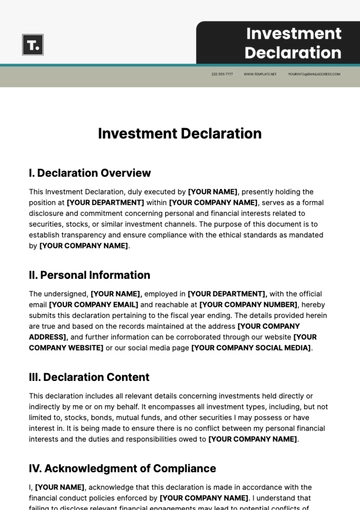Free Financial Investment Management

I. Investment Overview
Company Name: [Your Company Name]
[Your Company Name] is a distinguished entity in the financial investment landscape, recognized for its strategic approach and commitment to delivering exceptional value to its clients. Our firm is built on a foundation of expertise, integrity, and innovation, offering bespoke investment solutions that cater to the unique needs and aspirations of each client. We stand as a beacon of trust and excellence in the industry, continually evolving to meet the dynamic needs of the market and our diverse clientele.
Investment Philosophy: Our investment philosophy centers on creating long-term value through a diversified portfolio that balances growth and risk.
At [Your Company Name], our investment philosophy is anchored in the principle of creating sustainable, long-term value. We believe in a meticulous balance of growth and risk, ensuring that our clients' portfolios are not only resilient in diverse market conditions but also primed for growth. Our approach is holistic, considering global economic trends and individual client objectives, to construct portfolios that are diversified across asset classes, sectors, and geographies. This philosophy underpins our commitment to stewarding our clients' assets towards enduring success.
Investment Goals: To achieve a steady growth rate of 7% annually while maintaining a moderate risk profile.
The cornerstone of our investment strategy at [Your Company Name] is to target a consistent growth rate of 7% annually. This objective is carefully calibrated to align with a moderate risk profile, ensuring that we maximize returns while judiciously managing risk. We employ advanced analytical tools and market insights to identify opportunities that can contribute to this goal, always prioritizing the long-term financial well-being and goals of our clients. Our tailored strategies are designed to navigate market fluctuations effectively, aiming for steady and sustainable growth.
Risk Tolerance Level: Moderate, with a focus on balancing equity and fixed-income securities to mitigate volatility.
Our approach to risk management at [Your Company Name] is defined by a moderate tolerance level, meticulously designed to balance the growth potential of equities with the stability of fixed-income securities. This strategic balance is key to mitigating market volatility and protecting the investments of our clients. By continuously monitoring market trends and adjusting allocations as needed, we ensure that each portfolio remains aligned with individual risk preferences, thereby optimizing the risk-return profile in a way that instills confidence and achieves financial objectives.
Investment Horizon: Long-term investment strategy targeting a period of 10-15 years.
At [Your Company Name], we advocate for a long-term investment horizon, typically spanning 10-15 years, as we believe this timeframe is essential for realizing the full potential of investment strategies. This long-term perspective allows us to leverage market cycles, capitalize on compounding growth, and buffer short-term market volatilities. Our focus is on building portfolios that not only endure over time but also evolve in alignment with changing market conditions and client objectives, thereby ensuring that our clients' investments are well-positioned for sustained growth and success.
II. Asset Allocation Strategy
In this section, we delve into the Asset Allocation Strategy, a crucial component of investment management. It outlines our approach to distributing investments across various asset classes, details our rebalancing methodology, and describes how market conditions influence our strategic adjustments. This systematic approach is designed to optimize returns while managing risk effectively.
A. Target Asset Allocation
Diversification across 60% equities, 30% bonds, and 10% alternative investments.
Asset Class | Allocation Percentage | Description |
Equities | 60% | Broad exposure to various sectors and geographies, focusing on growth potential and resilience. |
Bonds | 30% | Diversification in fixed-income securities to provide stability and income. |
Alternative Investments | 10% | Investments in assets like real estate, commodities, and private equity to enhance diversification and potential returns. |
B. Rebalancing Strategy
Portfolio rebalancing semi-annually or when any asset class deviates more than 5% from its target allocation.
Rebalancing Trigger | Action |
Semi-Annual Check | Review and adjust the portfolio every six months to align with the target asset allocation. |
Deviation Beyond 5% | Rebalance any asset class that deviates more than 5% from its target allocation to maintain the intended risk-return profile. |
C. Market Conditions Considerations
Adjustments to the strategy will be made in response to significant economic changes, market volatility, or shifts in monetary policy.
Market Condition | Strategic Response |
Economic Changes | Adjust allocations in response to macroeconomic shifts, considering impacts on different asset classes. |
Market Volatility | Increase allocation to more stable assets during high volatility to protect the portfolio's value. |
Monetary Policy Shifts | Adapt bond and equity positions in anticipation of interest rate changes and their impact on markets. |
III. Performance Monitoring and Reporting
This section focuses on evaluating and communicating the portfolio's performance against established benchmarks. It involves regular, detailed reports that offer insights into how investments are faring in comparison to market indices, thereby guiding strategic decisions and adjustments.
A. Performance Benchmark
The selection of the S&P 500 and Bloomberg Barclays US Aggregate Bond Index as benchmarks is a strategic decision, allowing for a comprehensive evaluation of our portfolio's performance. Equities are measured against the broad market index of the S&P 500, providing a clear picture of how our stock selections perform in the context of the larger market. Similarly, the performance of our fixed-income investments is gauged against the Bloomberg Barclays Index, a key indicator for bond market movements. This approach ensures that our performance assessment is grounded in a relevant and objective market context.
B. Reporting Frequency
Our commitment to transparency and ongoing communication is reflected in our quarterly performance reports. These reports offer a detailed analysis of the portfolio's composition, its performance metrics, and an in-depth market analysis. This regular interval ensures that our clients are well-informed about their investments, enabling them to see the progression of their portfolios over time. The reports also provide an opportunity to review and reassess investment strategies, ensuring they remain aligned with our clients' goals and the changing market landscape.
C. Performance Metrics
Our evaluation process is anchored in a comprehensive set of performance metrics. Total return is the primary measure, capturing the overall rate of return, including both capital gains and dividends. We juxtapose this against relevant benchmarks to assess how the portfolio is performing relative to the broader market. Additionally, we place significant emphasis on risk-adjusted returns, which offer insight into the efficiency and effectiveness of our investment choices. This multifaceted approach to performance metrics allows for a nuanced understanding of portfolio success, considering both returns and the risks taken to achieve them.
IV. Risk Management and Compliance
This section delineates the framework for Risk Management and Compliance, crucial for ensuring the safety and legal integrity of investments. It comprises detailed strategies for mitigating risk, a robust compliance framework adhering to regulatory standards, and stringent internal control procedures. These elements are fundamental to maintaining the highest standards of investment practice and client trust.
A. Risk Mitigation Strategies
Implementation of diversification across sectors and geographies, regular portfolio stress testing, and use of hedging strategies where appropriate.
Strategy | Description |
Sector and Geographic Diversification | Distributing investments across various sectors and regions to reduce risk associated with any single area. |
Portfolio Stress Testing | Regularly simulating extreme market conditions to assess portfolio resilience and response strategies. |
Hedging Strategies | Utilizing financial instruments like options and futures to offset potential losses in the portfolio. |
Dynamic Asset Allocation | Continuously adjusting asset allocation in response to market shifts to optimize risk-return balance. |
Liquidity Management | Ensuring sufficient liquidity in the portfolio to meet short-term obligations and respond to market events. |
B. Compliance Framework
Strict adherence to regulatory standards, including SEC guidelines and international investment regulations.
Compliance Standard | Description |
SEC Guidelines | Adhering to regulations set by the Securities and Exchange Commission for transparency and fairness |
International Investment Regulations | Complying with global investment laws to ensure ethical and legal practices across borders. |
Anti-Money Laundering Policies | Implementing measures to prevent money laundering activities in all investment transactions. |
Privacy and Data Protection | Ensuring client data confidentiality and compliance with data protection laws. |
Conflict of Interest Policies | Maintaining policies to identify and manage conflicts of interest within investment decisions. |
C. Internal Control Procedures
Regular internal audits and reviews, continuous monitoring of investment restrictions, and adherence to ethical investment practices.
Procedure | Benefits |
Regular Internal Audits | Identifies potential issues in operations, ensuring adherence to policies and regulations. |
Continuous Investment Restrictions Monitoring | Ensures portfolio remains within set investment limits and guidelines. |
Ethical Investment Practices | Upholds moral and ethical standards in investment choices, fostering client trust. |
Periodic Review of Compliance Policies | Keeps the firm updated with evolving regulations and standards in the financial industry. |
Client Feedback Mechanism | Facilitates transparency and continuous improvement through client input and experiences. |
V. Client Communication and Service
This section is foundational to building and maintaining strong client relationships. It encompasses strategies for effective communication, personalized relationship management, and high standards for customer service. This tripartite approach ensures clients are well-informed, their unique needs are met, and they receive exceptional support.
A. Client Communication Methods
Our communication framework is designed to keep clients informed and engaged. Regular email newsletters provide insightful updates on market trends and portfolio performance. Additionally, our secure web portal offers clients real-time access to their portfolio data, enhancing transparency and ease of access. We also value personal interaction, hence, annual in-person meetings are scheduled to review financial goals, portfolio performance, and discuss potential strategy adjustments. This multi-faceted approach ensures clients are well-informed and connected at all times.
B. Client Relationship Management Strategies
At the heart of our service is personalized client relationship management. We understand that each client's financial goals and life circumstances are unique, and our investment advice is tailored to these individual requirements. Our strategies are not static; we actively incorporate client feedback and adapt to life changes, ensuring that our portfolio management remains relevant and effective. Proactive engagement is our key tool, allowing us to maintain a pulse on our clients' evolving needs and preferences.
C. Customer Service Standards
Our commitment to customer service is unwavering. We pride ourselves on having a dedicated client service team, available to provide support, address inquiries, and ensure overall client satisfaction. Our response time commitment is a testament to our dedication to client needs. Furthermore, we engage in a continuous improvement process, actively seeking and incorporating client feedback to enhance the quality of our services. This commitment ensures that our clients not only receive responsive support but also feel valued and heard.
Through these focused efforts in communication, relationship management, and customer service, we strive to provide an exceptional experience that meets and exceeds our clients' expectations.
Thank you for choosing [Your Company Name] for your financial investment management needs! We look forward to a successful journey together.
- 100% Customizable, free editor
- Access 1 Million+ Templates, photo’s & graphics
- Download or share as a template
- Click and replace photos, graphics, text, backgrounds
- Resize, crop, AI write & more
- Access advanced editor
Maximize wealth with Template.net's Financial Investment Management solution. Secure, customizable, optimally designed to render top-notch investment strategies. Effortlessly editable in our Ai Editor Tool. Gain control, establish your financial dominance. Experience exceptional monetary management, envisage a prosperous future. Navigate complex finance seamlessly. Choose Template.net, secure your financial destiny today.





























